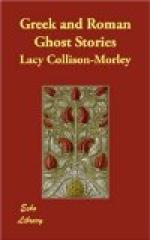The head of the family walked through the house with bare feet at dead of night, making the mystic sign with his first and fourth fingers extended, the other fingers being turned inwards and the thumb crossed over them, in case he might run against an unsubstantial spirit as he moved noiselessly along. This is the sign of “le corna,” held to be infallible against the Evil Eye in modern Italy. After solemnly washing his hands, he places black beans in his mouth, and throws others over his shoulders, saying, “With these beans do I redeem me and mine.” He repeats this ceremony nine times without looking round, and the spirits are thought to follow unseen and pick up the beans. Then he purifies himself once more and clashes brass, and bids the demons leave his house. When he has repeated nine times “Manes exite paterni,” he looks round, and the ceremony is over, and the restless ghosts have been duly laid for a year.
Lamiae haunted rooms, which had to be fumigated with sulphur, while some mystic rites were performed with eggs before they could be expelled.
The dead not yet at rest were divided into three classes—those who had died before their time, the [Greek: aoroi], who had to wander till the span of their natural life was completed;[23] those who had met with violent deaths, the [Greek: biaiothanatoi]; and the unburied, the [Greek: ataphoi]. In the Hymn to Hecate, to whom they were especially attached, they are represented as following in her train and taking part in her nightly revels in human shape. The lot of the murdered is no better, and executed criminals belong to the same class.
Spirits of this kind were supposed to haunt the place where their bodies lay. Hence they were regarded as demons, and were frequently entrusted with the carrying out of the strange curses, which have been found in their tombs, or in wells where a man had been drowned, or even in the sea, written on leaden tablets, often from right to left, or in queer characters, so as to be illegible, with another tablet fastened over them by means of a nail, symbolizing the binding effect it was hoped they would have—the “Defixiones,” to give them their Latin name, which are very numerous among the inscriptions. So real was the belief in these curses that the elder Pliny says that everyone is afraid of being placed under evil spells;[24] and they are frequently referred to in antiquity.
FOOTNOTES:
[Footnote 1: Tusc. Disp., i. 16.]
[Footnote 2: Ov., Fast., iv. 821; Fowler, Roman Festivals, p. 211.]
[Footnote 3: Macrob., Sat., i. 16.]
[Footnote 4: Cic., De Leg., ii. 22.]
[Footnote 5: “Deum parentem” (Corn. Nep., Fragm., 12).]
[Footnote 6: Cp. Fowler, Rom. Fest.]
[Footnote 7: Rohde, Psyche, p. 216. Cp. Herod., iv. 26.]




